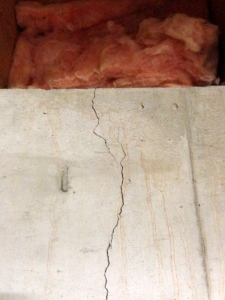Reader Question: Monty, I built my house back in 2001. I have a concrete driveway that is 250′ long. It started to lift (push up) in the center of the slabs within years 4-5. Over the last 3-4 years, it has drastically been lifting up. The base of the driveway is slag. The builder put it down in January and poured the drive in July. He said that should be sufficient time for it should settle. Friends that have worked with concrete told me that slag was a poor choice. Apparently, it releases gas, and that is why my driveway is coming apart. I asked my builder if he could say something to his concrete subs. He agrees it is pretty bad and said he would never use slag again. He is telling me to forget about it. Is there a legal recourse, being that it has been over 10 years? Thanks for your time Monty. Mark.
Monty’s Answer: Hi Mark, my answer is to consult with your attorney. The laws governing situations of this nature vary from state to state. I suspect the time limit assumption is correct. In my home state, the statute of limitations is six years; the only exception is first-degree homicide, which has no limitation. In any event, it sounds like the builder, and his concrete subcontractor, erred in some fashion here. Concrete cracking is particularly common in northern climates.
The slag may not be the cause of the problem. There are many materials used for base under concrete slab construction. What material one selects varies regionally on availability, the materials properties and the condition of the sub soil under the base.
There are a number of articles on the web where slag is named as a material for the construction of road base. Did the builder use slag in the construction of other driveways? If so, have they developed the same condition? Have your friends used slag with concrete that failed as the reason for their belief? Do other builders in your area use slag? I understand gas generated in the production of slag burns off or is removed during the process, but can the driveway be tested for its presence?
Here is a link to an article about slag. In addition to its use in the production of concrete, the article states another common use of slag is fertilizer. Are there large trees growing within 25 feet of your driveway? If so, could the slag be acting like a steroid and beefing up the root systems of the trees?
With a driveway 250 feet long I assume the home has a septic system. Most states required soil boring’s taken to determine soil conditions are suitable for that system. Check that soils report to see if it reveals what soil types are beneath the slag. It may be valuable to take soil borings right in the middle of the driveway’s high point to see exactly what is underneath the slag. This may be beneficial in pre-determining the cost to repair or replace the driveway. If the soils were the cause, the slag base would have to be removed to prepare the soil. Then determining material substitutions for the base or the finished surface become easy.
Some detective work and asking knowledgeable people can determine what, exactly, is the cause of the problem. While it could be the slag, I suspect there are other more likely suspects; poor compaction at construction, poor or inconsistent sub soil, or the roots on steroids. Be certain about the cause to prevent history from repeating itself when you replace the broken concrete. Consider utilizing a knowledgeable concrete contractor if you replace the concrete.
I hope this information helps you get to the bottom of the situation, Mark. Please ask if you have other questions.
Regards,
Monty


Leave a Reply
You must be logged in to post a comment.